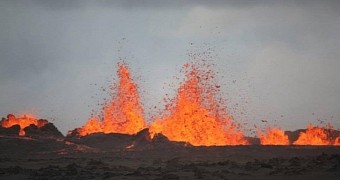Not too long ago, a volcano system in southeast Iceland started showing signs of unrest. Thus, thousands of earthquakes were documented over the course of just 2 weeks. Just a few hours ago, things took a turn for the worse.
Specifically, observers say that, this past August 31, a volcanic eruption sent lava about 200 feet (a little over 60 meters) into the air. As noticeable in the photo next to this article, no significant amounts of ash were released.
Information shared with the public says the lava emerged from a crack in the Holuhraun field, which is part and parcel of Iceland's remote Bárðarbunga volcanic system. The crack is said to measure nearly 1 mile (roughly 1.5 kilometers) in length.
Observers in the area say that the lava flow is continuous. It is estimated to be about 0.6 miles (nearly 1 kilometer) wide and 1.9 miles (approximately 3 kilometers) long. Despite its impressive size, the flow appears to be rather calm.
“The eruption is a very calm lava eruption and can hardly be seen on seismometers (almost no gosórói). Visual observation confirm it is calm, but continuous,” specialists with the Iceland Met Office said in a statement concerning this event.
“The fissure eruption is continuing at a stable level. No explosive activity is observed, the eruption remains an effusive lava eruption,” they went on to explain. By the looks of it, the eruption resulted in reduced seismicity as a result of pressure release.
According to Live Science, lava was documented to be coming out of the ground at a rate of 15.9 million gallons per minute (approximately 1,000 cubic meters per second). Since ash release was minimum, visibility remained largely unaffected.
Hence, airports in Iceland were allowed to remain open, and no commercial flights were canceled or forced to take another route, Iceland Magazine informs. Still, it is to be expected that should the lava field begin spewing out ash, air travel in this part of the world will be affected.
This fairly impressive volcanic eruption that was reported in the area just yesterday was preceded by a slightly calmer one that occurred towards the end of last week, on Friday. At that time, the crack that is now coughing out lava was significantly smaller. Besides, this first eruption only lasted a few hours.
Specialists are now busy keeping a close eye on Iceland's Holuhraun lava field, and promise to soon share more information with the public. In their latest report, they say that no obvious changes in lava flow were documented until the early hours of the morning of September 1.

 14 DAY TRIAL //
14 DAY TRIAL //